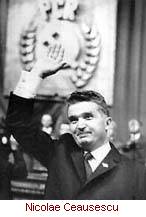|
|
|
|

|
Romania
|
The Soviet army enters Romania.
Soviet pressure leads to the creation of a predominantly Communist goverment in Romania under the non-Communist Petru Groza.
Romania's monarchy is taken over by the Communist Party. Romania is renamed "The People's Republic of Romania". A constitution, similar to that of the Soviet Union, is established.
Romania's cultural and political institutions are reorganised to conform with Soviet models. Anyone suspected of being anti-Communist is removed from the political arena.
After the death of Stalin, Romania begins to assert its independence from the Soviet Union.
Romania rejects the plan of the Council for Mutual Economic Awareness (COMECON) to integrate the economies of the Communist states.
 Nicolae Ceausescu is chosen as the first secretary of the central committee of the Romanian Communist Party.
Nicolae Ceausescu is chosen as the first secretary of the central committee of the Romanian Communist Party.
Nicolae Ceausescu assumes the office of president of the state council, or head of state. He renames the country the Socialist Republic of Romania. Under Ceausescu, the press is censored and personal liberties are restricted.
President Richard Nixon visits Romania, improving ties between Romania and the West. This is followed by several visits by Ceausescu to the United States.
Ceausescu visits the People's Republic of China and signs economic treaties with China.
Romania and the United States sign a ten-year economic pact.
Ceausescu uses almost all of Romania's foreign currency reserves to pay off foreign debts. As a result, the standard of living drops drastically.
Ceausescu's brutal domestic policies lead to antigovernment demonstrations in Romania. When the army turns against him, he flees Bucharest with his wife. They are caught by the army and executed three days later.
After Ceausescu's leadership is toppled, the democratic multipartite system is reformed. The parliamentary system as well as the free press are reinstated in Romania. Despite these measures, antigovernment demonstrations continue. In December 1991, a new democratic constitution of Romania is adopted by popular referendum. Romania has and continues to experience significant ethnic turmoil relating to ethnic minorities in Romania.
|




 Nicolae Ceausescu is chosen as the first secretary of the central committee of the Romanian Communist Party.
Nicolae Ceausescu is chosen as the first secretary of the central committee of the Romanian Communist Party.
